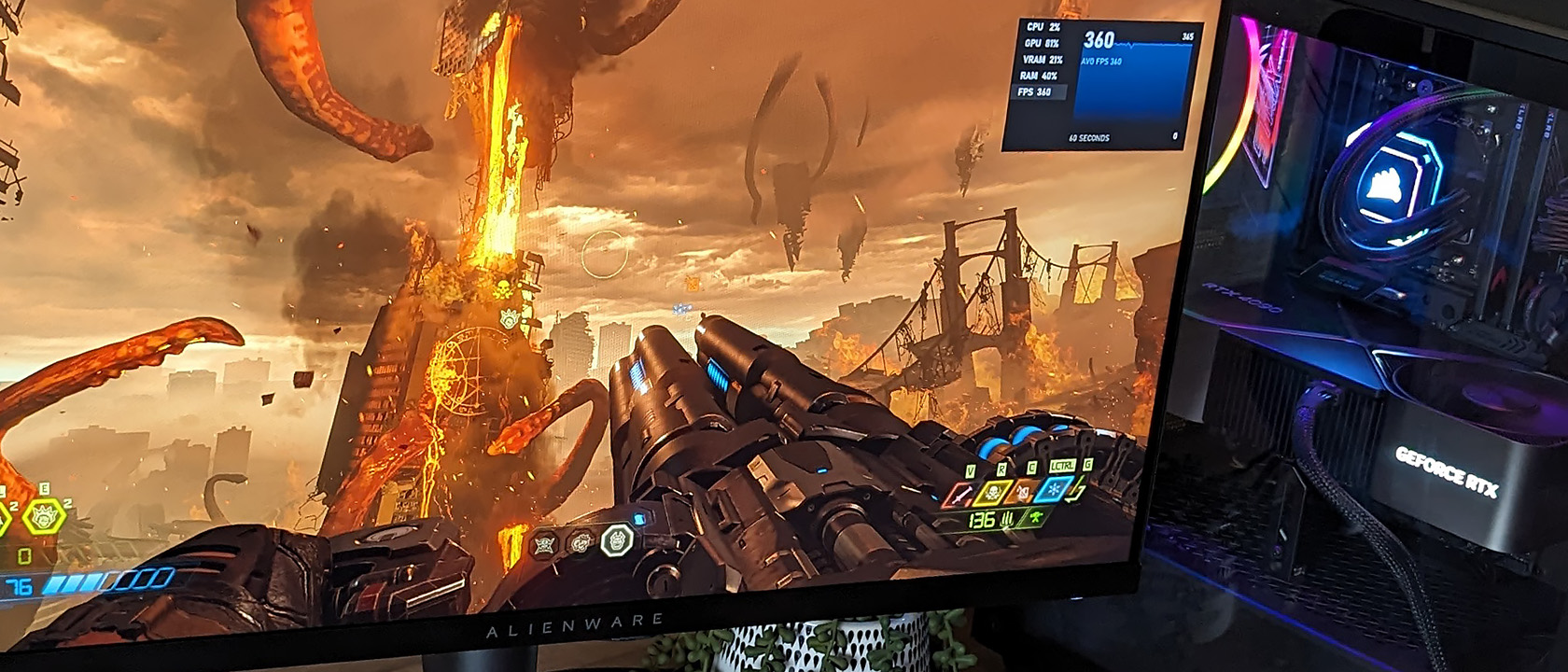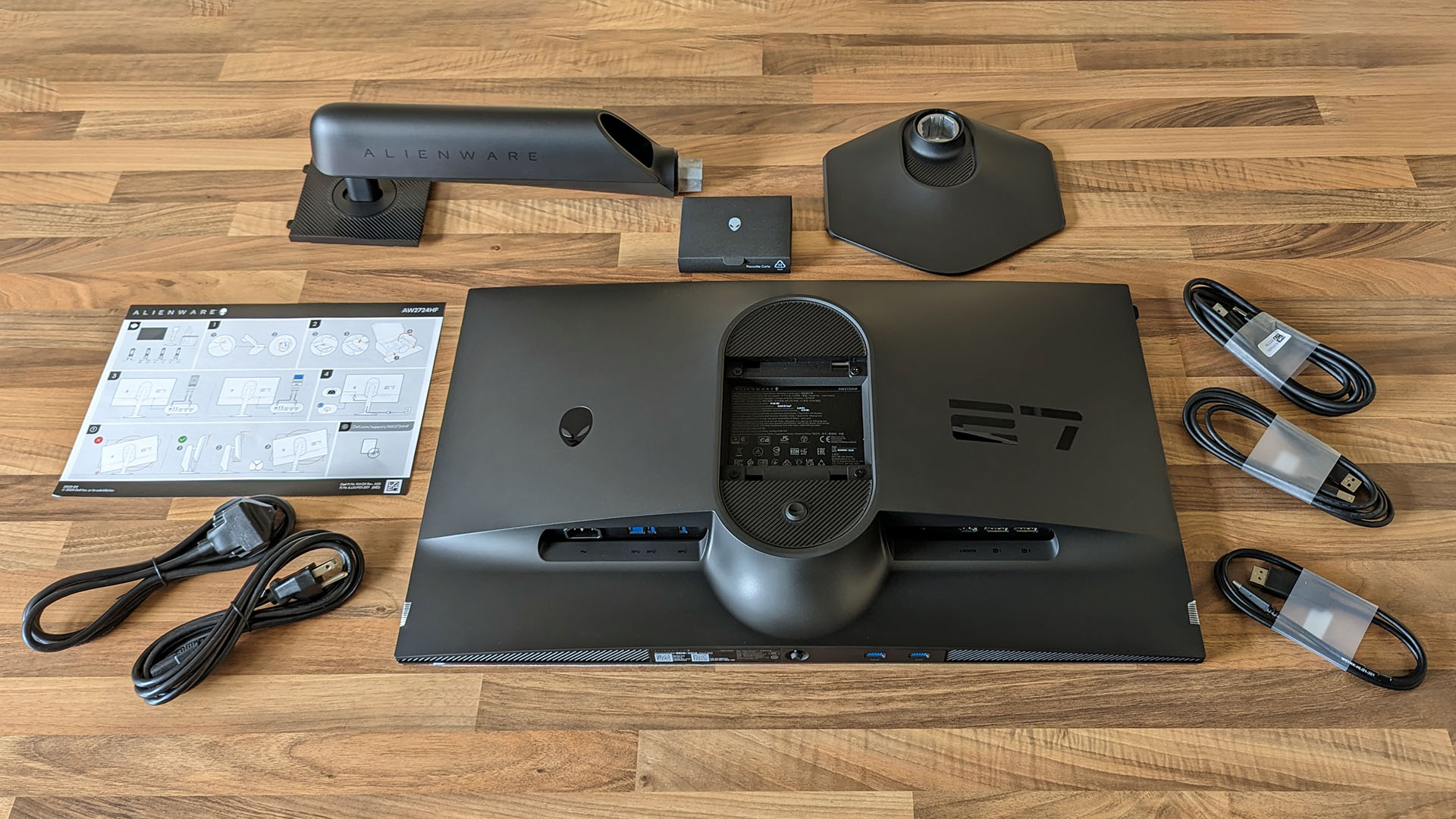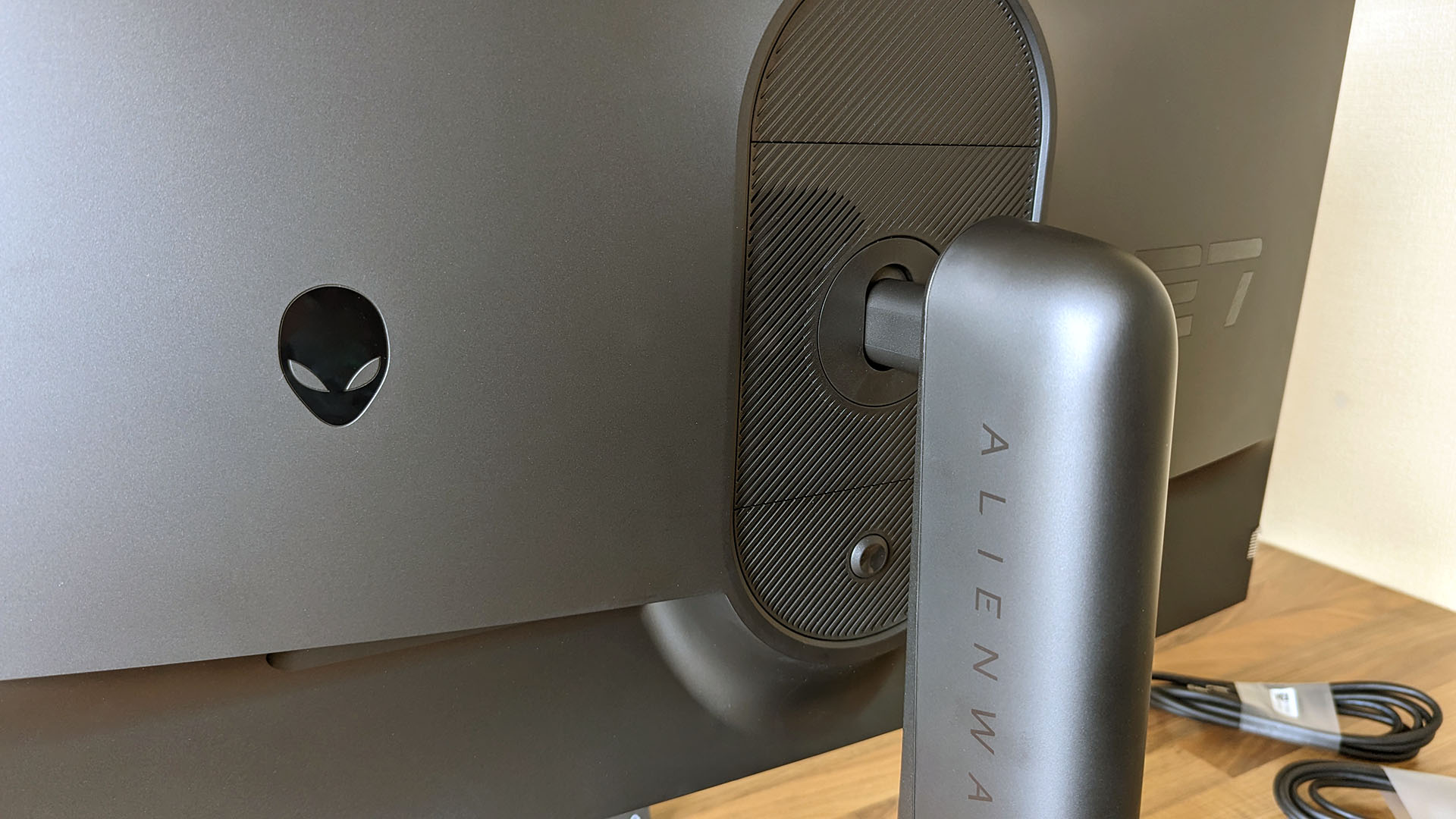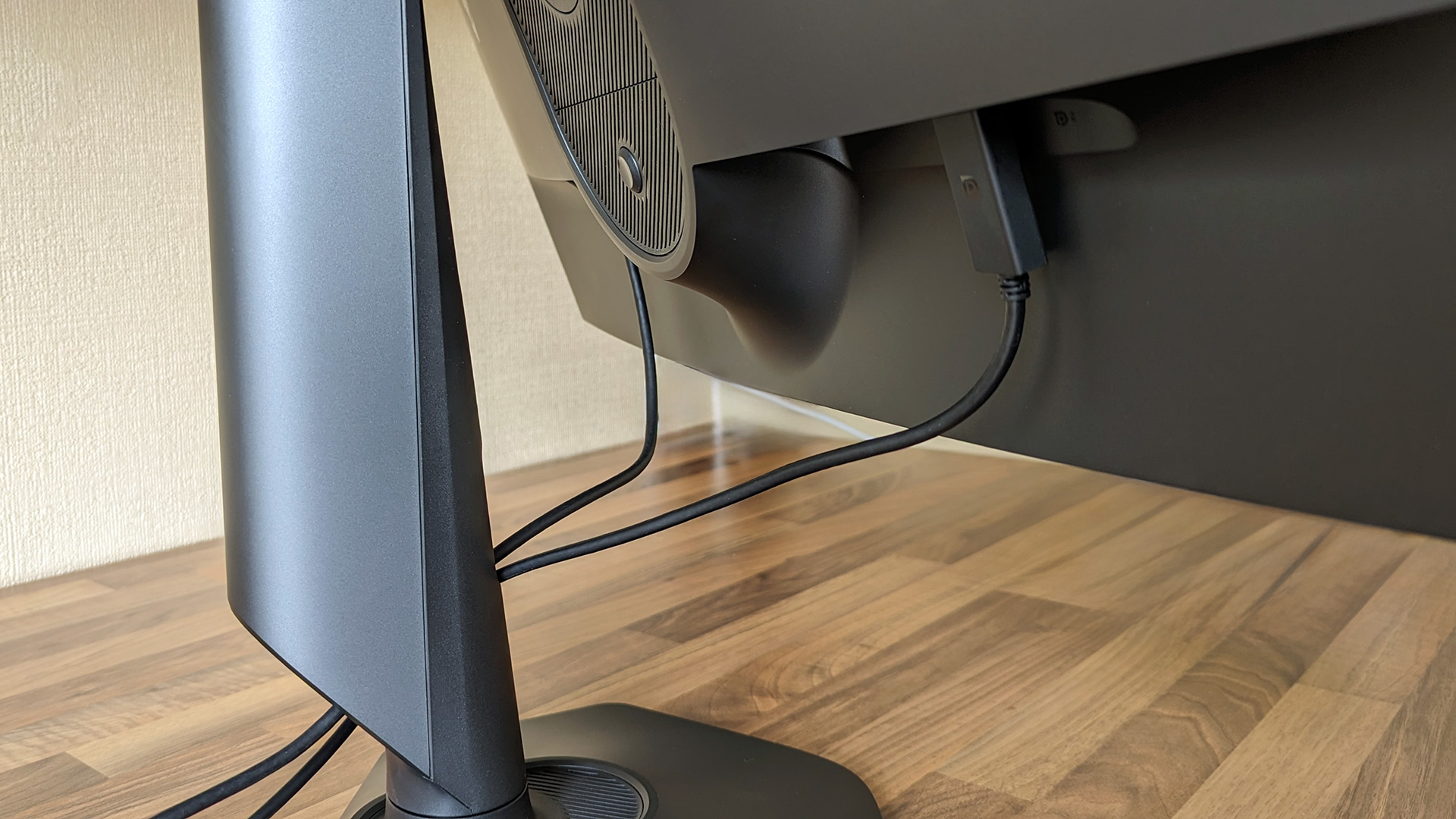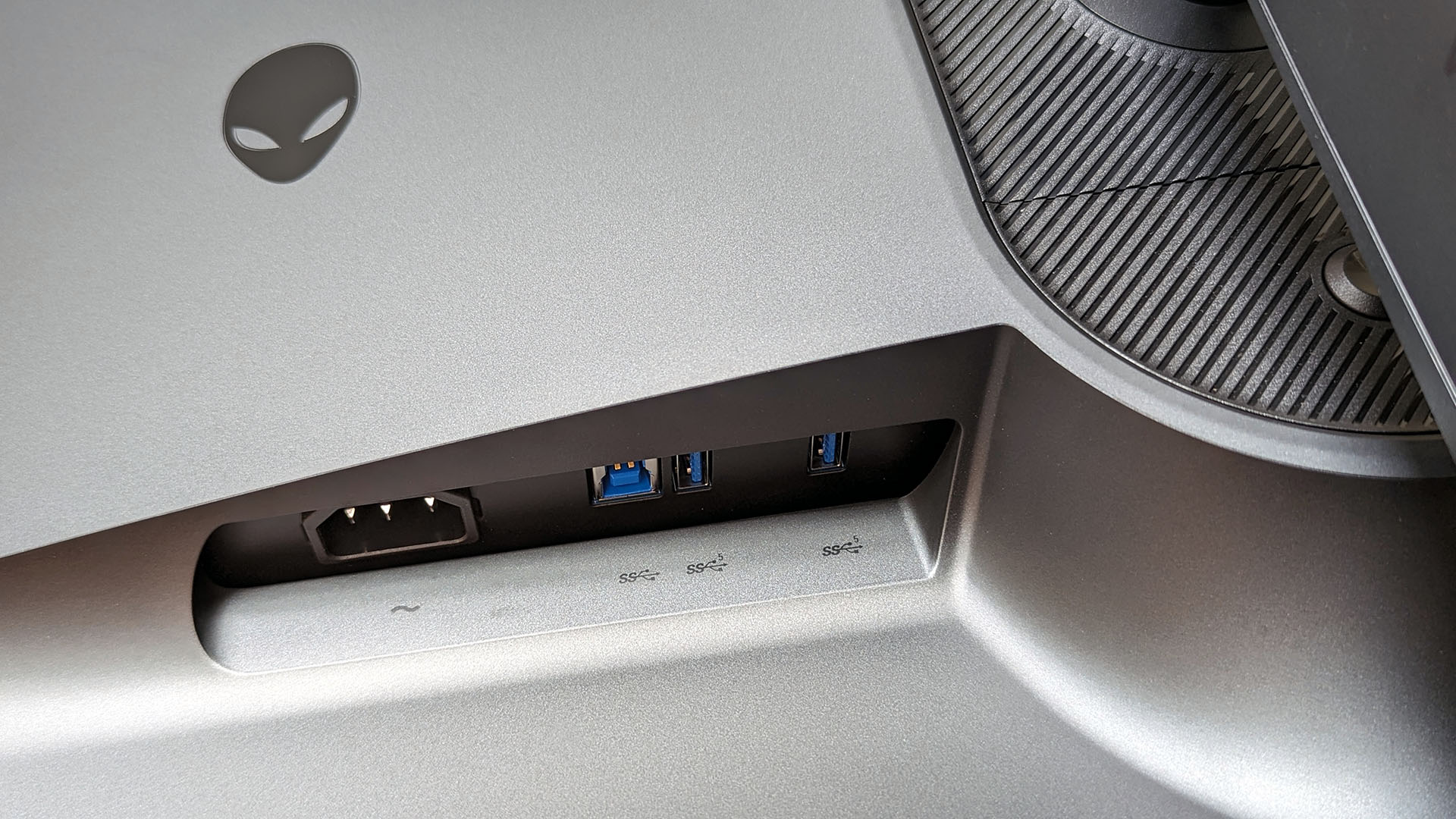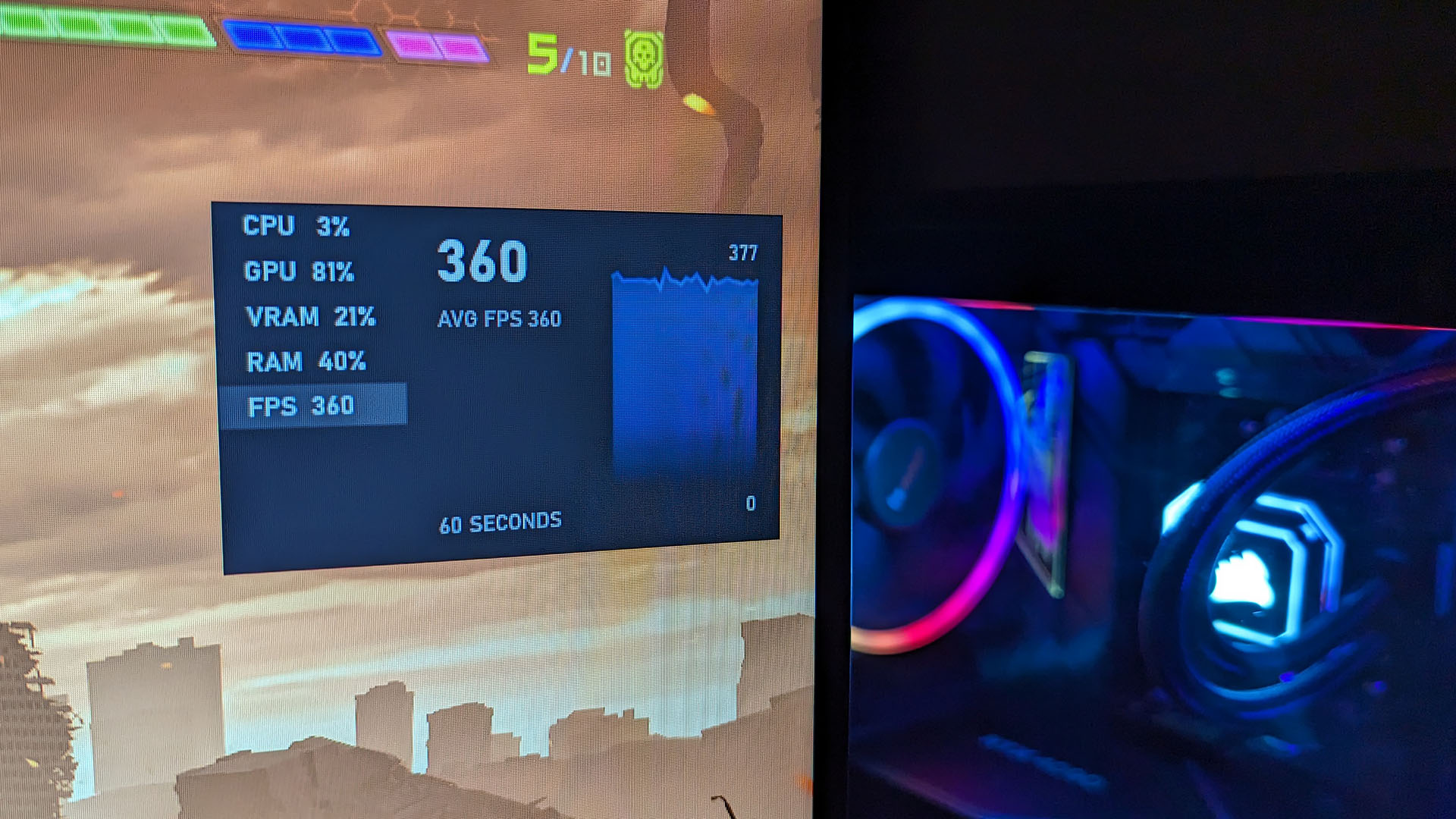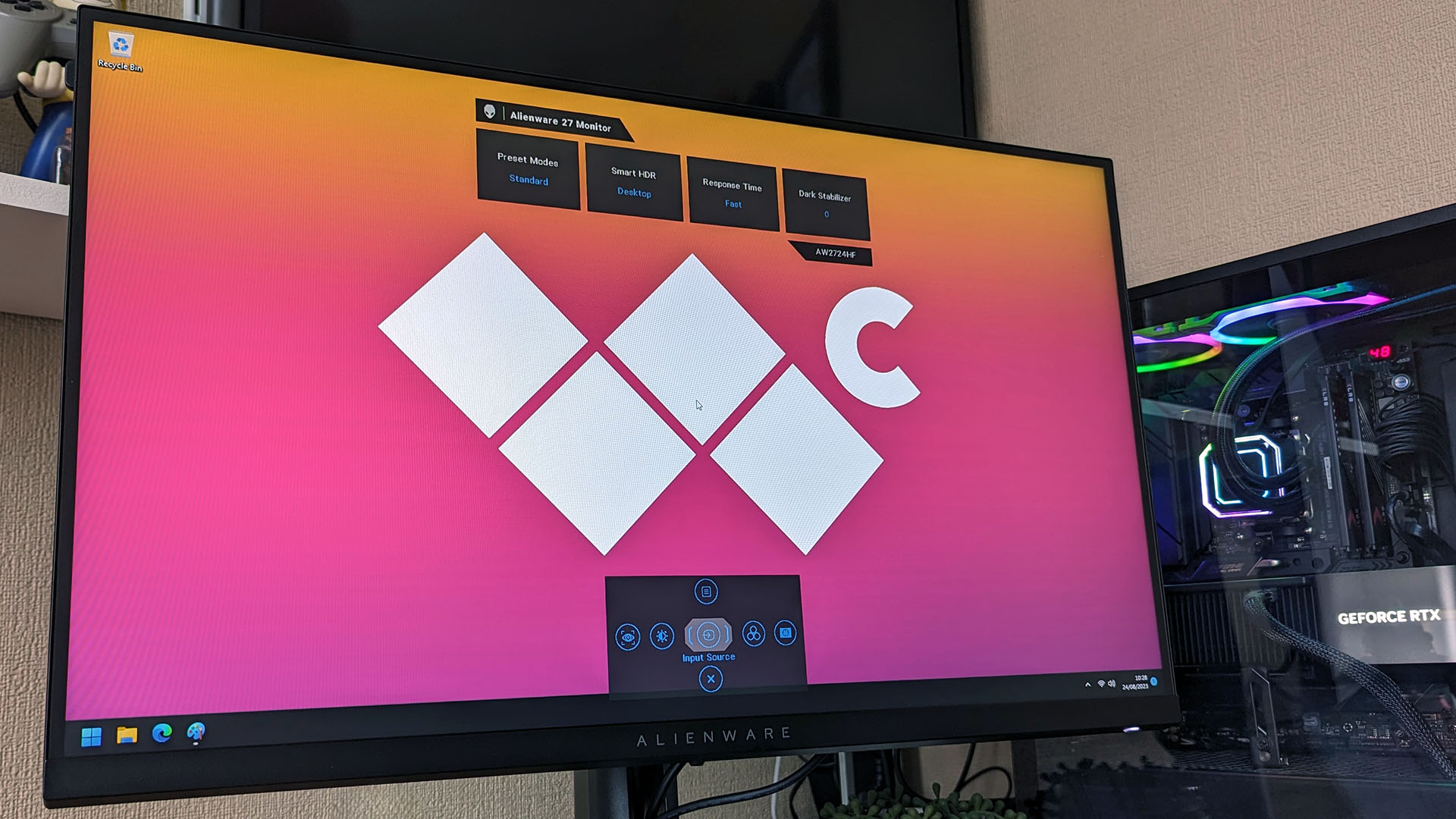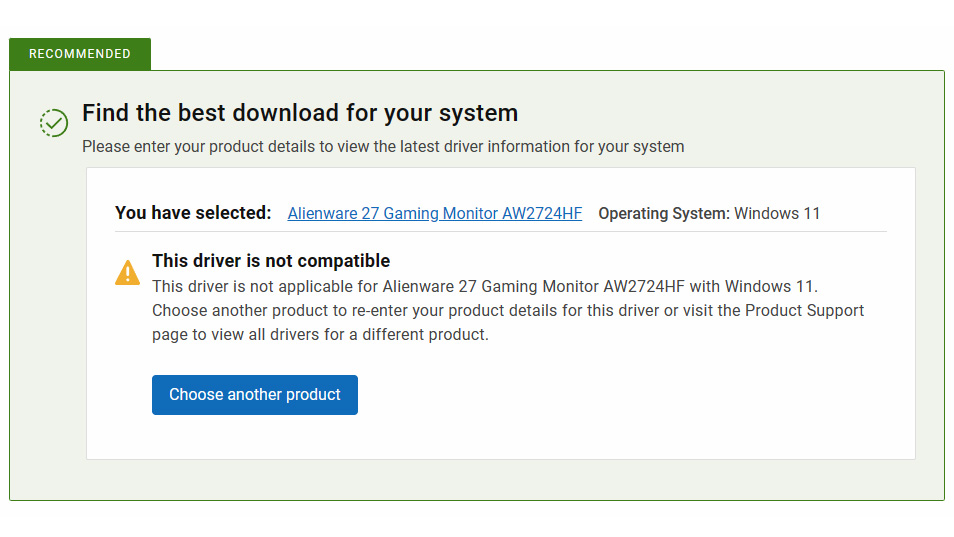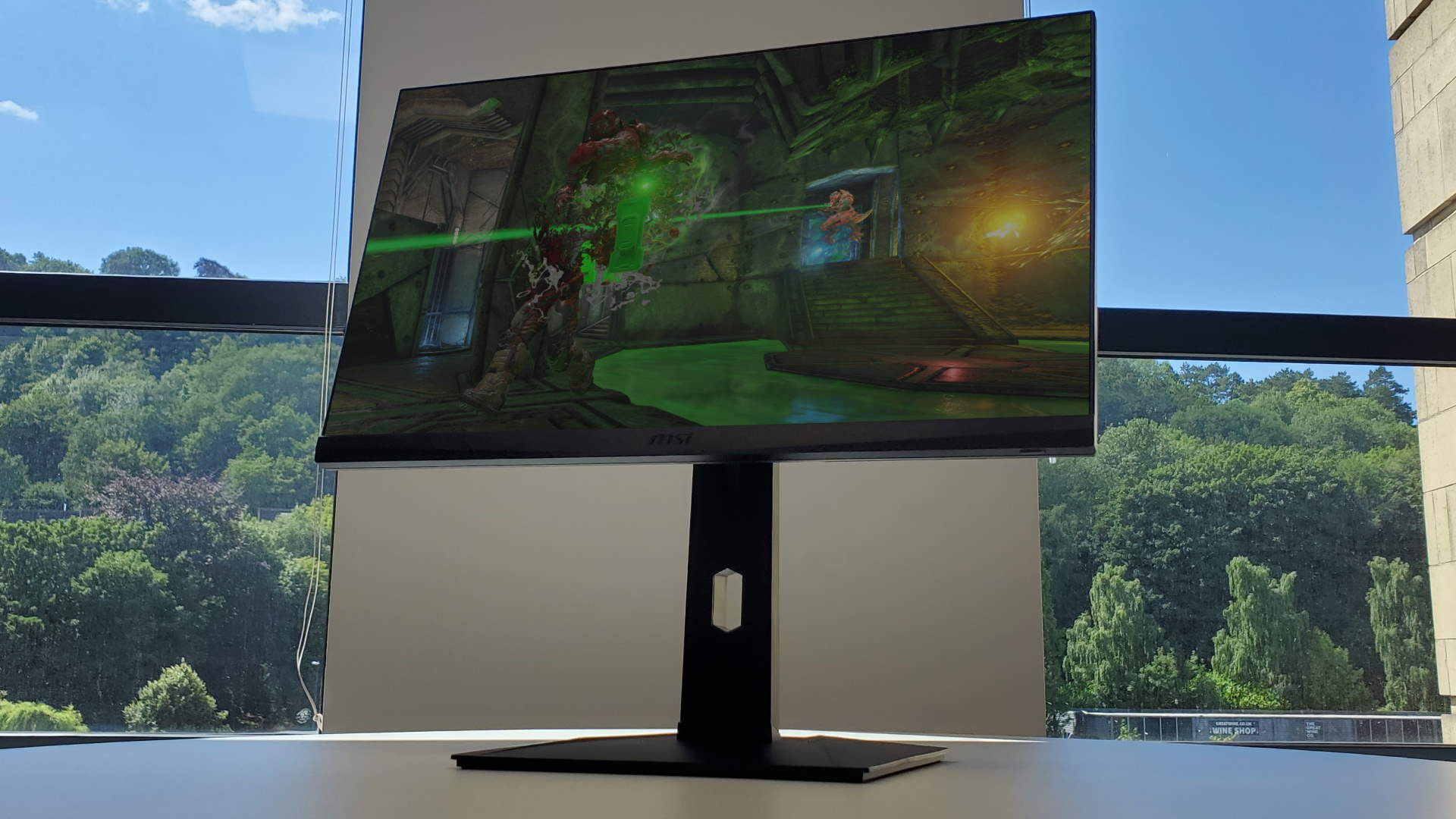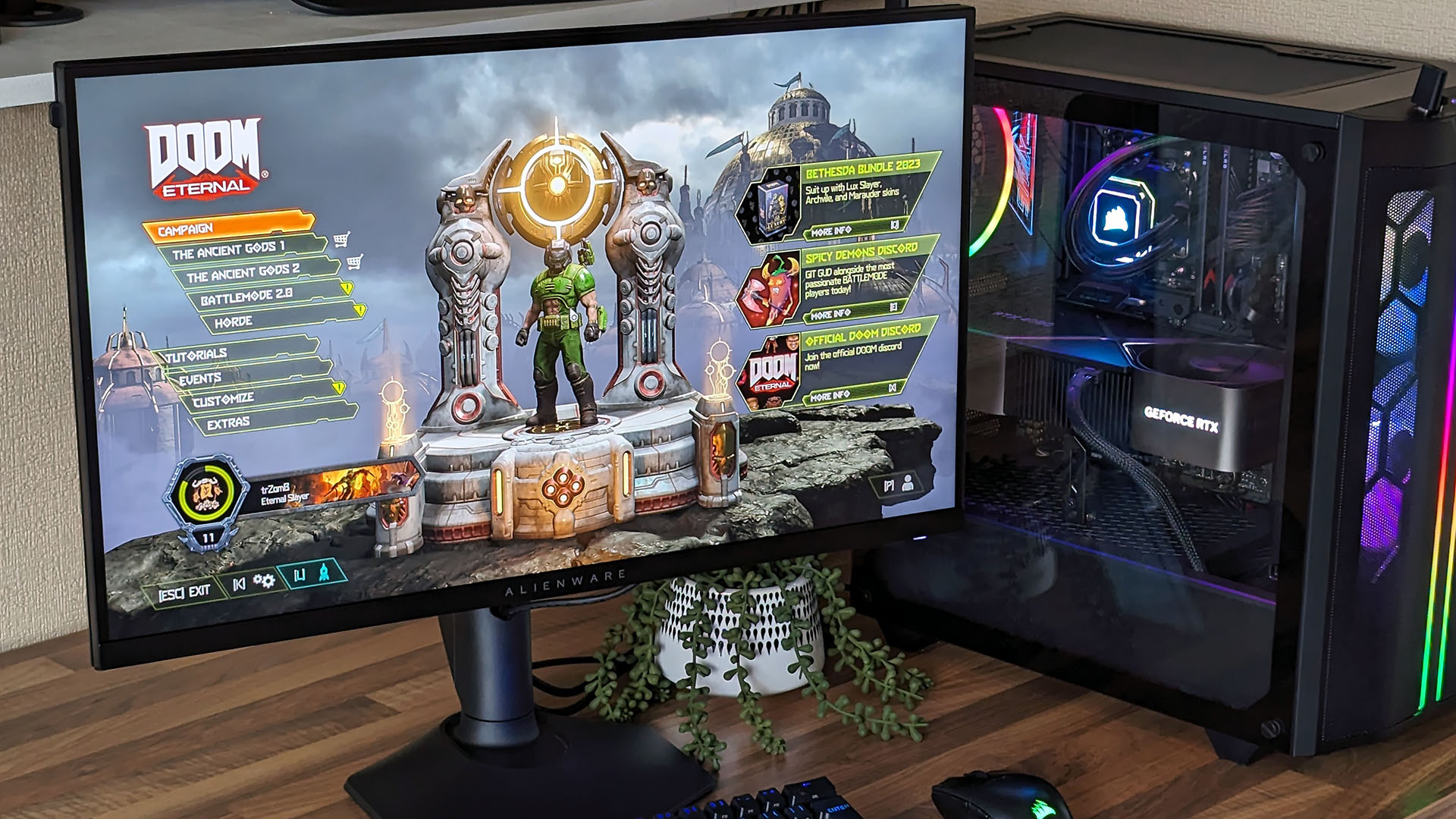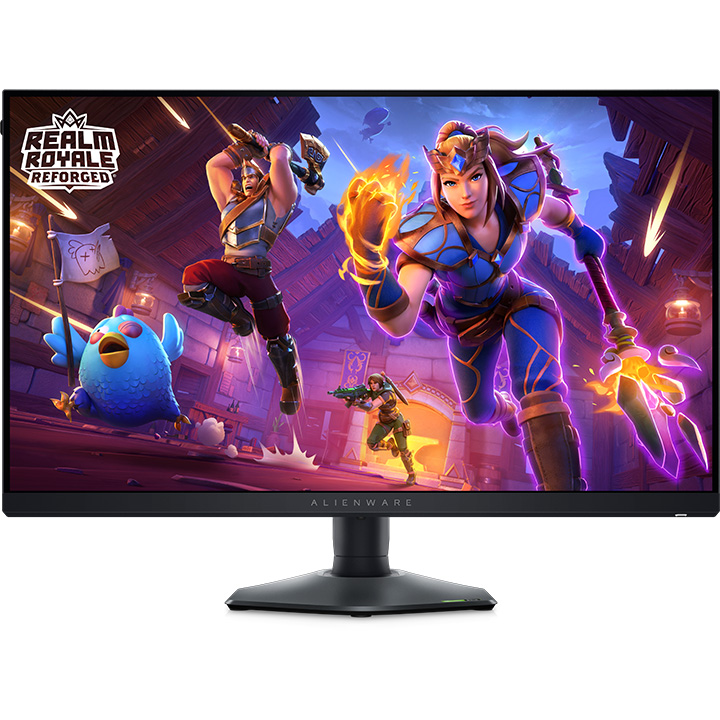Windows Central Verdict
Dell delivers what it promises, with a 360Hz refresh rate providing impossibly smooth gameplay if backed up by appropriately powerful hardware. Alternatively, drop the graphical settings and prioritize framerates if you don't mind the borderline ugliness of 1080p on an otherwise impressive 27-inch panel. Disappointing bugs plague another Alienware release, but they aren't total roadblocks.
Pros
- +
360Hz gaming, if your hardware can handle it.
- +
Generous tilt angle and easy vertical adjustment.
- +
Rotates to portrait mode for extra space saving.
Cons
- -
OSD bugs hamper the experience alongside Alienware Command Center woes.
- -
Ghosting is still visible in darker environments.
- -
HDR support isn't worth the brightness trade-off.
Why you can trust Windows Central
The best gaming monitors can often feel suspiciously similar to high-end panels aimed at creators, wrapped instead in ugly shells that wouldn't look out of place in a sci-fi UFO. At least, when it comes to Alienware, this 360Hz screen has a noticeable standout feature that appeals directly to a particular kind of consumer: the competitive gamer.
It's pushing the limits of 1080p at 27 inches, but for less than $500, the list of competitive-centric features alone is tempting if you can bag one of Dell's gaming-focused accessories that always come with a gorgeous (if sometimes unusual) aesthetic. Thankfully, the Alienware 27 gaming monitor, or AW2724HF for short, actually improves on previous-generation design choices, though somewhat falling short in other categories.
Disclaimer: This review was made possible by a review unit provided by Dell. The company did not see the contents of the review before publishing.
Alienware AW2724HF: Price, specs, and availability
Dell sells the Alienware AW2723DF through its official store for $459.99 MSRP. It's also available at Amazon UK for £399.99 RRP, but the US store currently does not have a listing. Packaged with a 6ft full-size DisplayPort cable and a shorter 3ft USB-C to DisplayPort variant alongside a USB 3.2 Gen 1 upstream cable, it's available for purchase now.
Price: $459.99 (MSRP)
Display: Fast IPS LED-backlit LCD / TFT
Resolution: Full HD (1920 x 1080)
Pixel per inch: 81.72
Refresh rate: 360 Hz (DP) 255 Hz (HDMI)
Response: 0.5 - 1 ms
Brightness: 400 cd/m²
Gamut: 99% sRGB
Contrast ratio: 1000:1 / 1000:1 (dynamic)
Viewing angle: 178°
Size: 24.1 x 9.6 x 16.1 in (lowest position)
Weight: 9.2 lbs (without stand)
Although the Dell store page shows customizable options, the model number changes to reflect the different features. This means that while this particular monitor isn't configurable, there are alternatives.
For example, the Alienware 25-inch AW2523HF still offers a 360Hz refresh rate, but its physical size reduction comes with a slight price drop to $449.99 MSRP ($419.99 with a discount at the time of writing.)
Alternatively, selecting a QHD (2560 x 1440) resolution will present you with the Alienware 27-inch AW2724DM for $399.99 MSRP (discounted to $359.99 on sale,) but the maximum refresh rate drops to 165Hz.
All the latest news, reviews, and guides for Windows and Xbox diehards.
Only the 27-inch AW2724HF model covered in this review features the exact configuration of a 1080p resolution and 360Hz refresh rate, so double-check specification changes when navigating the official store.
Alienware AW2724HF: Setup and design
Alienware is fast becoming my favorite monitor brand, thanks to a few factors, but mostly their laughably effortless construction. If you were planning a LAN PC multiplayer event and needed to set up monitors quickly, you would fall in love with the two-step stand attachment that has barely changed since I reviewed the 27-inch Alienware AW2723DF last year.
You still don't need a single tool to assemble this well-presented gaming monitor; just a few minutes and a clear desk. Opening the box reveals a top-level compartment with a still-reasonably generous collection of cables, including an old-school USB-B (yes, like a printer) for the hub of ports mounted on the underside. A tiny box emblazoned with the Alienware logo contains more comprehensive documentation, but you won't need more than the quick-start guide.
Dell still recommends that you attach the desk stand directly to the rear of the monitor while it remains in the box. The soft packaging helpfully separates to give you easy access to the fixtures, still featuring a straightforward pushbutton quick release. If not, the front of the panel also has a soft protective covering attached with small pieces of tape, so you can assemble it on your workspace if you prefer.
One of the most immediately noticeable changes to this particular monitor from Alienware is the lack of a plastic port cover, which appears in other variants, appearing in our review of the larger 34-inch AW3423DWF. You can still feed cables through the neck of the stand, which undoubtedly helps keep things tidy, but it's a shame to pass on a skinny plastic panel, even on a monitor with a lower MSRP.
On the other hand, the other obvious difference is the considerable size reduction of the desk stand. It's one of the only complaints I had when advising whether or not to buy the 27-inch AW2723DF, with its gigantic feet encroaching on smaller desks, so the hexagon-shaped footplate on this new offering is a massive improvement regarding the size. The design of the desk stand might be somewhat less exciting, but the trade was worth it.
Adjusting the monitor left and right is far easier on this year's model, too, owing to the stand's redesign. You still can't quite move it with one hand since that causes the entire unit to shift out of place, but using a second hand to keep things steady allows for smoother, minor movements. Vertical adjustment is a one-handed affair, although pushing the monitor downwards is tougher than the spring-loaded assistance that activates while pulling it upwards.
A tiny headphone stand pops out of the left side with a push and is just as quickly pushed away if you need to angle the monitor vertically. Rotating the screen is straightforward if you don't have any cables routed through the desk stand for management, but it's far more annoying for a quick change since you'll need to pull everything through for the required slack.
You'll need the monitor raised at least a little before spinning around to a vertical position, but you can angle the panel backward with a pretty generous lean, which certainly helps. It seems unlikely that anyone will set up a 360Hz monitor in the vertical position, doomed to scroll Discord and Steam at high framerates forever, but it's nice to have the option.
The selection of ports on this monitor is well hidden but not entirely impossible to access from the front thanks to the generous amount of tilt angles offered by the desk stand. At the very least, you have two USB-A 3.2 Gen 1 ports alongside the combination power and menu rocker just under the frame, perfect for wireless keyboard and mouse receivers or compact external storage.
Alternatively, two more USB-A 3.2 Gen 1 lurk further behind the panel, usually where I connect my long-term peripherals, alongside AC power and the USB-B hub port that connects all of this to a desktop or laptop. On the far side, your video-in options include a single HDMI and double DisplayPort, the latter with an included USB-C conversion cable for any compatible devices.
For under $500, it's easy on the eyes, and I'd be happy to have it alongside similarly-themed hardware.
There's no rear facing RGB or anything fancier than an illuminated power switch on the underside of the panel to the right. Besides the Alienware logo stamped on the bottom, the 27-inch AW2724HF would look fairly unassuming if it weren't for the hexagonal desk stand, but it's not a dull-looking monitor. For under $500, it's easy on the eyes, and I'd be happy to have it alongside similarly themed hardware.
Alienware AW2724HF: 360Hz mode and features
Naturally, the most apparent reason to search out reviews for this monitor is to determine if the outrageous 360Hz maximum refresh rate is worth it. It's not even the absolute limit for Alienware, with a recently-announced 500Hz gaming monitor coming in at a slightly smaller 25-inch with a 1080p native resolution. Still, the relatively low asking price for this 27-inch option makes it a tempting buy for those who crave impossibly smooth framerates.
The good news is that you can enjoy 360Hz in Windows 11 without any effort beyond changing the refresh rate from the default 60Hz on boot, and the OSD joystick hidden underneath the monitor's frame offers an 'Extreme' mode to bring the response rate down as low as 0.5ms. You'll need to use either the included full-size DisplayPort cable or the DisplayPort to USB-C alternative for gaming laptops since HDMI can only reach a measly 255Hz, so consider your GPU output options.
The bad news comes in the way of a few minor annoyances that feel like teething problems that could be fixed with firmware updates, something we've seen repetitively in Alienware hardware reviews recently. The AW2724HF is listed with HDR10 support, but I had to disable 'Smart HDR' in the OSD menu before Windows 11 would detect this as an HDR-compliant monitor.
Issues with the OSD itself hamper making changes like this, regularly refusing to remain on screen after pressing the multi-function joystick button underneath. A single push often shows a hint of the available menus. Yet, it usually disappears after barely a second, remedied only (but not consistently) by turning the screen off entirely and booting it again. It doesn't happen every time, but it was more often than not.
Dell's companion app for its gaming-centric hardware, 'Alienware Command Center,' is the usual go-to place for troubleshooting. It's automatically installed by Windows Update when compatible devices are detected but refuses to boot and detect the AW2724HF monitor. Navigating to the official download page currently displays an incompatibility error, but the AW2724HF support page provides a link to an installer for the app.
Offering the option to repair the Alienware Command Center, the manual installer fixes the damaged background service that comes with the Windows Update variant. However, after a system reboot, the app still refuses to open. My colleague Zachary Boddy used an entire Alienware gaming setup for a month, and the Command Center app was unfortunately highlighted for its shortcomings.
Further troubleshooting research allows you to finally launch the bugged Alienware Command Center, but it doesn't work out of the box.
Installing the official AW2724HF driver gives you a couple of official color profiles, but it doesn't fix the frustrating disappearing OSD issue. Further troubleshooting research can allow you to finally launch the bugged Alienware Command Center, but it doesn't work out of the box, and novice users won't have a satisfactory experience.
Thankfully, none of the issues are complete roadblocks, and you can still use every feature advertised on the official Alienware AW2724HF store listing. Still, daily annoyances will soon build up into genuine frustration that could see users opting to ditch hardware that struggles to balance its benefits against minor bugs. Thankfully, Dell is listening to feedback and is well aware of issues with its software, claiming improvements are on the way, so it's not all bad news.
Alienware AW2724HF: Display benchmarks
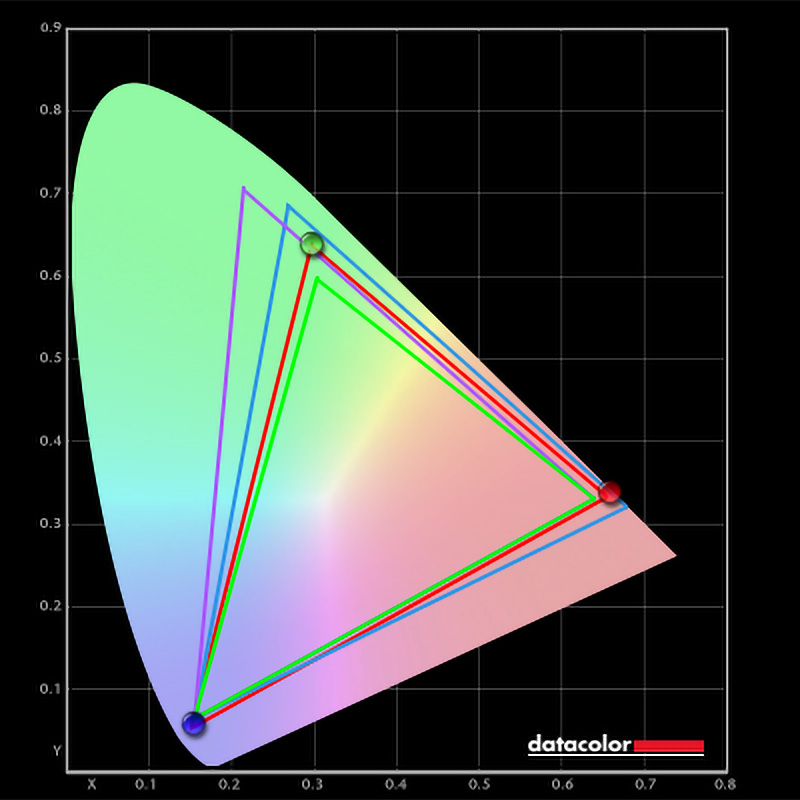
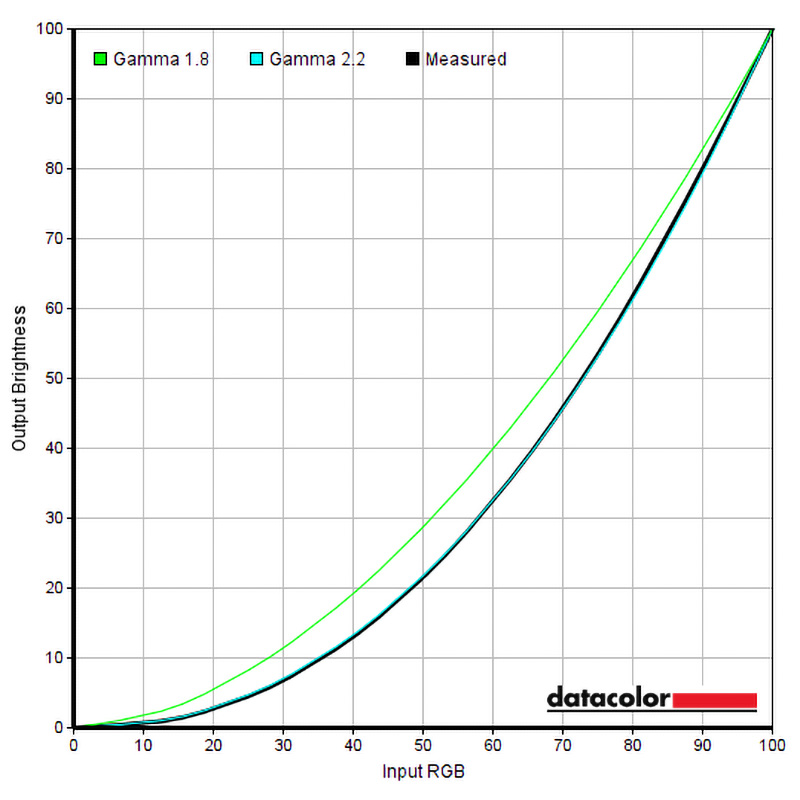
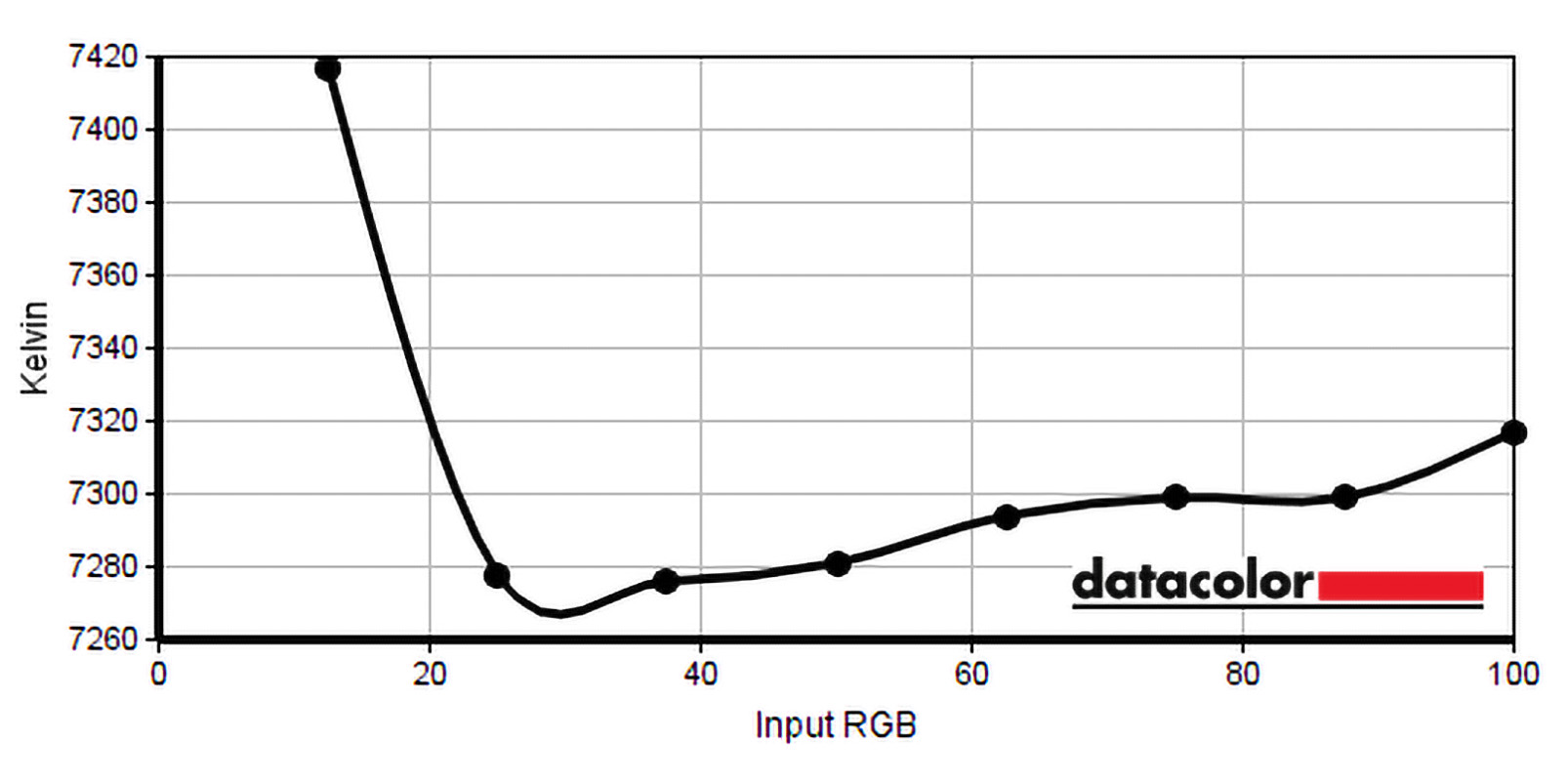
Testing the AW2724HF with a SpyderX Pro colorimeter isn't particularly intensive since this monitor only targets 99% accuracy for the sRGB color gamut (used for everyday web browsing and gaming.) The advertised number is slightly exceeded in the first test with 100% sRGB accuracy, so there are no issues here.
As mentioned above, as 'Smart HDR' is disabled by default, Windows 11 reports this monitor as unable to display HDR content. Switching this mode to the 'Desktop' profile flicks a digital switch to enable HDR mode (and auto HDR for supported games.) It also deactivates manual brightness control on the OSD, affecting test results.
| Setting | Brightness | Black | Contrast | White Point |
|---|---|---|---|---|
| 0% | 39.1 | 0.05 | 880:1 | 7300 |
| 25% | 92.8 | 0.09 | 1020:1 | 7300 |
| 50% | 145.4 | 0.16 | 910:1 | 7300 |
| 75% | 196.5 | 0.21 | 950:1 | 7300 |
| 100% | 462.6 | 0.43 | 1070:1 | 7300 |
With HDR activated, the display stays at 257 nits, somewhere between the 75% and 100% setting in regular operation. Thankfully, it's a reasonably comfortable brightness level, so no complaints there. However, the contrast drops to 590:1 with HDR, providing a black level of 0.43, the same as 100% brightness. Unless you're playing a game that spectacularly utilizes HDR, it's nothing to write home about.
Frankly, if you asked a room full of games to raise their hands if they use HDR, you'd likely only accumulate enough people for a game of Solitaire. It's not a crowd that particularly cares about high dynamic range, which probably explains the lack of promotion for this feature on the store listing. Still, it works and is there if you really want it.
There are noticeable ghosting trails behind fast-moving objects in darker scenes, no matter which response profile is selected.
Unfortunately, the most significant downside found in testing comes from ghosting. No matter which response time profile is selected, from 'Fast' to 'Extreme,' there is a noticeable trail behind fast-moving objects, particularly in darker scenes. Stick to web browsing or apps with a light mode, and you'll likely miss it, but loading into games with moody atmospheres like DOOM Eternal exposes the effect.
Alienware AW2724HF: The competition
This is a niche category, but it's not as sparse as you might think. There are many tempting options, but PC Gamer praises the $400 MSI OCULUX NXG253R for its vivid color response and a more reasonable 24.5-inch size that better suits the 1080p resolution. You still get a 360Hz maximum refresh rate with a 1ms response rate, which naturally comes with DisplayPort connectivity, but HDMI is there as a backup for 240Hz.
Affordability is a curious topic when considering the hardware needed to run games at 360 FPS. Anything more intensive than Vampire Survivors (which, of course, I tried first) will need some considerably high-end PC components to get anywhere close. For total transparency, I tested this monitor with an NVIDIA GeForce RTX 4090 Founder's Edition GPU, which carries a $1,599 MSRP. Sure, it makes short work of DOOM Eternal at 360Hz, but that's not a surprise.
Stick to competitive multiplayer games where ultra-smooth framerates can make a difference, and the AW2724HF or any alternative offering the same refresh rate makes more sense. Most gamers in this bracket don't really care about graphical fidelity anyway, prioritizing FPS over fancy effects, so they'll likely be happy with any option. Just double-check they actually provide real-world performances like Alienware does here.
Alienware AW2724HF: Should you buy it?
You should buy this if …
• You're a competitive gamer craving smooth framerates
Higher FPS makes the most significant difference in multiplayer, where every millisecond counts. The AW2724HF provides exactly what it promises and will hit 360 FPS if your hardware can handle it.
• You're cramped for desk space
The compact, hexagon-shaped desk stand makes a massive difference compared to previous-generation Alienware monitors, and its smooth adjustment for vertical, horizontal, and even rotated angles is ideal for smaller desks.
You should not buy this if …
• You're a creator prioritizing color accuracy
Although Dell exceeds its claim and hits 100% accuracy for the web-based sRGB color gamut, the performance of AdobeRGB and DCI-P3 falls to 85% and below. This is a monitor for gamers, not creators.
• You want Ultra HD clarity
Dell is pushing the limits of 1080p on this 27-inch panel, which becomes painfully evident under close inspection. Individual pixels are clearly visible, and games won't render natively at anything higher.
To its credit, the Alienware AW2724HF delivers on almost everything it promises. You can play competitive games at 360Hz right out of the box with the stutter-free benefits of AMD FreeSync Premium. However, while the response rate does hit as low as 0.5-1ms, it doesn't completely eliminate ghosting in darker environments. You'll hardly notice it during fast-paced gameplay, but seeing your mouse trails on dim loading screens might get tiring.
A desk stand redesign means far less wasted space on cramped desks, and the monitor frame looks as sleek as ever, owing to Alienware's beautiful aesthetics. It rotates freely, with a generous amount of tilt and effortless vertical adjustment. However, the software experience doesn't match the hardware, with more pained issues relating to its companion app (not that you'll likely need it more than once.)
It's a decent price for 360Hz, but 1080p starts to look ugly at 27 inches. Consider the capabilities of your hardware and gameplay needs and whether the tempting MSRP is worth it, though it certainly seems so at under $500. Perhaps not quite the best gaming monitor for everyone, the AW2724HF has its place among competitive multiplayer fans.

Ben is a Senior Editor at Windows Central, covering everything related to technology hardware and software. He regularly goes hands-on with the latest Windows laptops, components inside custom gaming desktops, and any accessory compatible with PC and Xbox. His lifelong obsession with dismantling gadgets to see how they work led him to pursue a career in tech-centric journalism after a decade of experience in electronics retail and tech support.
